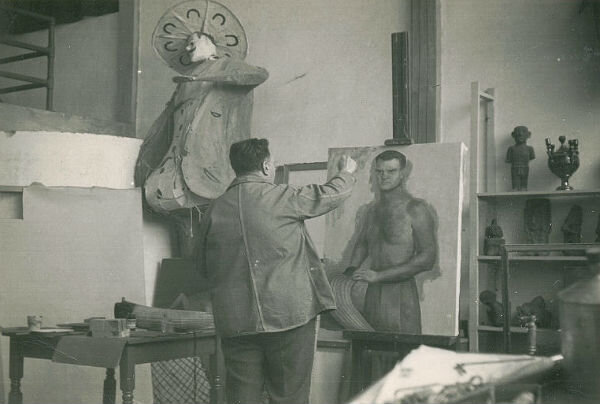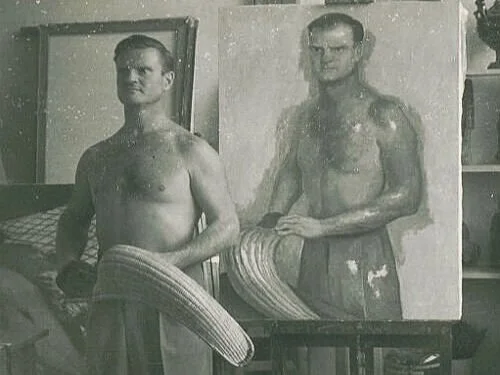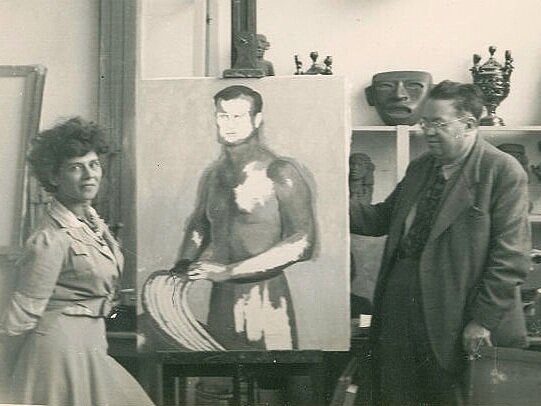Ep. 10: WWII: A Sailor, a Jai Alai Portrait, and a Stalinist Composer
Europe is at war and US involvement imminent. For those Europeans living and working in Mexico City, concerns mount about displaced relatives, and immigrants pour into the country.
WWII: Louis Stephens and his two sons, Luis and Charles.
When the United States enters WWII, Louis Stephens becomes determined to enlist in spite of his 41 years. On February 15, 1942, he registers with his local draft board in Brooklyn. In April 1943 he begins to make inquiries about getting a commission as an officer in the armed forces and writes to the commander of the Naval Aviation Executive Corps asking to join. Finally, Louis Stephens left Mexico for New York where he stood in line at a recruiting center and enlisted in the Navy as an ordinary seaman.
Annette was furious with Stevie for enlisting at his age and leaving her with two boys to care for. But things had not been good in their marriage for a while. Annette issued a heated ultimatum—if he went to war, she would not be waiting for him when he returned. They agreed to keep their difficulties from the boys and to wait until after the war to divorce.
Before Stevie left for war, Annette commissioned a portrait of him by Diego Rivera. Diego painted Stephens as a jai alai player, bare chested and showing off his strong, athletic body, wearing the bowl-shaped “cesta” basket on his right hand. Stevie reported that, during the sittings for the portrait, Diego often boasted he had once been a famous Jai Alai player himself, an obvious falsehood that he “embellished with details about teams, players, tournaments, and championship matches.” Stevie, like Bertram Wolfe in his book about Rivera, described Diego as a “mythomaniac,” referring to his tendency to enlarge upon his adventures.
For three months, Annette mourned Stevie’s absence and threw herself into her painting. That year she met Conlon Nancarrow, an American composer, in an event “that changed both our lives radically.”* Conlon was very handsome, somewhat skinny, a bit taller than Annette, and dressed beautifully. They met at a party given for Freddie Martin, a nurse in the Spanish Civil War. Nancarrow had come to Mexico City after being kicked out of the United States when he returned from two years in the Spanish Civil War. Annette was 36 and Conlon was 31. They began a friendship, which quickly ripened into an intense physical relationship.
It was truly a case of opposites attracting—in many ways they were an unlikely pairing. Conlon was essentially a hermit. When they’d go to a cocktail party, he would have a drink and find a chair in some corner, smoke either a French Gauloise or Mexican Delicado, and never speak to anyone until she was through socializing. Annette drew Nancarrow into a life that was much fuller than he, being a confirmed introvert, would likely otherwise have experienced.
When WWII ended there were joyous reunions across Europe, the United States, the Pacific Basin, and in Mexico as fighting men returned home. Many do not realize that, at the US government’s urging and after the sinking of two Mexican oil-tankers by German U-boats, Mexico declared war on the Axis powers in May 1942. They became known as the 201st Mexican Fighter Squadron, arriving in the Philippines in March 1945 as a part of the Fifth Air Corps USAAF, flying Republic P-47 Thunderbolts. They flew 59 combat missions, beginning with four fighter sweeps over the Japanese-held island of Formosa and an attack against the port of Karenko. When the war ended, Mexico City went wild with ticker parades to welcome their boys home.
By this time Annette had broken off with Conlon, wanting to give her marriage another try, but Stevie had somehow found out about their affair and, when the war ended, he called Annette to come to Los Angeles to begin divorce proceedings. Annette and her two boys would spend six weeks in Reno, Nevada. Louis Stephens would remarry soon after and Annette and Conlon in 1946.




